Class Aves
Order Accipitriformes
Family Cathartidae
Coragyps atratus/occidentalis—Black or Western Black Vulture // Coragyps occidentalis—Western Black Vulture
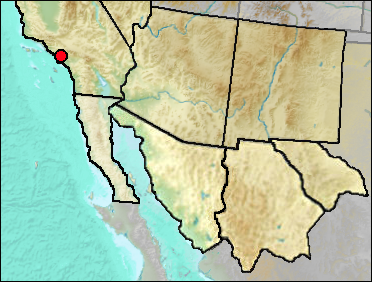
Sites.
Sangamon: San Pedro Lumber Co. (Jefferson 1991a)
Literature. Jefferson 1991a.
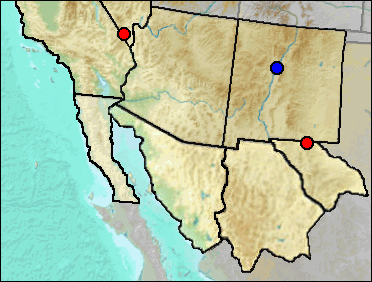
Brodkorb (1964) reported the Black Vulture from Burnet Cave and from Albuquerque. Howard (1968) considered the Burnet Cave and Albuquerque specimens as critical to an understanding of the relationship between C. atratus and C. occidentalis; occurrence of both in the Late Pleistocene would imply that they were separate species rather than the latter evolving into the former. However, the Burnet Cave (=Rocky Arroyo) specimen, according to Howard (1968), lies at the extremes of this species and Coragyps occidentalis—that is, close to the maximum for C. atratus and the minimum for C. occidentalis. There are no published measurements for the Albuquerque specimen (Brodkorb Collection), so it cannot be evaluated at present. It may be argued that the Burnet Cave specimen shows intermediacy because it represents the transition from the larger C. occidentalis to the smaller C. atratus. On the other hand, Burnet Cave includes Holocene material as well as Pleistocene.
Santucci et al. (2001) stated that C. atratus is documented from Dust Cave, but gave no indication that the atratus/occidentalis situation was considered. Likewise, Reynolds, Reynolds, and Bell (1991) listed without comment C. atratus from Devil Peak.
Although likely a single phylogenetic line, I will treat them as separate species for the time being (a change from the earlier announced position). This is primarily a matter of convenience rather than a considered taxonomic decision and hopefully will be revisited later.
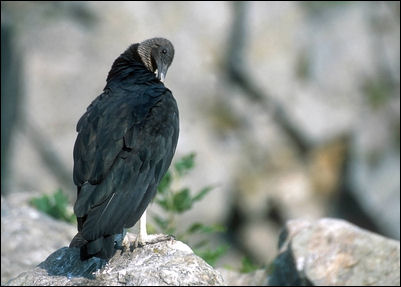 Fig. 1. Black Vulture (Coragyps
atratus). Photograph by John J. Mosesso, courtesy National Biological Information
Infrastructure.
Fig. 1. Black Vulture (Coragyps
atratus). Photograph by John J. Mosesso, courtesy National Biological Information
Infrastructure.
Currently the Black Vulture is considered accidental in New Mexico, with only a few occurrences in the southern part of the state. It occurs in southern Arizona and is recorded also from Presidio County in the Big Bend of Texas.
Sites.
Pleistocene: Albuquerque.
Mid Wisconsin: Devil Peak (Reynolds, Reynolds, and Bell 1991).
Late Wisconsin: Dust Cave (Santucci et al. 2001).
Literature. Brodkorb 1964; Howard 1968; Reynolds, Reynolds, and Bell 1991; Santucci et al. 2001.
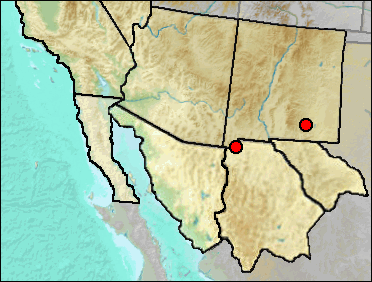
See comments above. The U-Bar Cave specimen is from miner's spoil.
Sites.
Mid Wisconsin-Holocene: U-Bar Cave (Harris 1993c cf.).
Late Wisconsin/Holocene: Burnet Cave (Wetmore 1932).
Literature. Harris
1993c; Wetmore
1932.
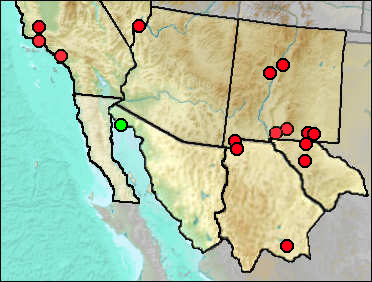
Synonyms. The Western Black Vulture was described by Miller (1909) as Catharista occidentalis.
It has most often been treated as a species separate from the Black Vulture (e.g., Howard 1968). It differs from the Black Vulture in greater size and in proportions, but not in qualitative characters (Howard 1968). It probably would be best to treat the taxon as a chronologic subspecies (see comments above) since, in all likelihood, the Western Black Vulture decreased in size around the end of the Pleistocene to become the Black Vulture of today (Steadman et al. 1994). A record from an Indian midden at Five Mile Rapids on the Columbia River (L. Miller 1957) produced one bone of Coragyps occidentalis; a 14C date is slightly less than 8000 years. Thus, if a chronological species, it retained the characteristic large size at least in part of its range well into the early Holocene.
This vulture apparently nested on ledges at the entrance to Dry Cave and within earlier fissure systems. Many elements are of immature, probably preflight birds. Similarly, occurrences in the older Dry Cave sites located beneath fissures that at one time intersected the surface also suggest local breeding. Preservation in many cases is excellent (Figs. 1 and 2).
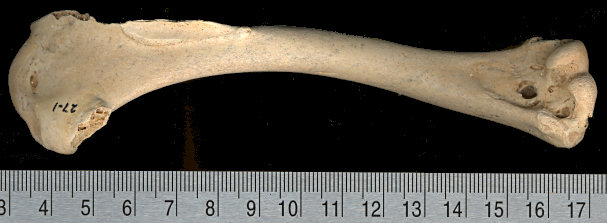
Fig. 1. Palmar view, left humerus of Coragyps atratus occidentalis (UTEP 27-1), Rm Vanishing Floor, Dry Cave, Eddy Co., NM. Metric scale.
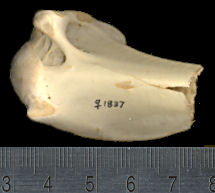
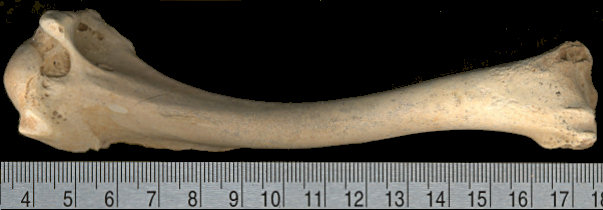
Fig. 2 (left). Anconal view, head of left humerus of modern Coragyps atratus. Fig. 3. Left humerus of Coragyps atratus occidentalis (UTEP 27-1), Rm Vanishing Floor, Dry Cave, Eddy Co., NM. Metric scale. Much of the deltoid crest is missing in this specimen.
Sites.
Irvingtonian: El Golfo (Croxen et al. 2007).
Wisconsin: Carpinteria (Guthrie 2009); McKittrick (Jefferson 1991a).
Early/Early-Mid Wisconsin: Balcony on Lost Valley (Harris 1993c); Lost Valley (Harris 1993c); Sabertooth Camel Maze (Harris 1993c); Rm Vanishing Floor (Harris 1993c).
Mid Wisconsin: Pendejo Cave (Harris 2003); U-Bar Cave (Harris 1993c).
Mid/Late Wisconsin: Dark Canyon Cave (Howard 1971); Hampton Court (Harris 1993c); NW Talus Slope (Harris 1993c); Pit N&W Animal Fair (Harris 1993c); Rampart Cave (Carpenter 2003).
Mid/Late Wisconsin/Holocene: Jimenez Cave (Messing 1986); Sierra Diablo Cave (UTEP).
Late Wisconsin: Animal Fair 18-20 ka (Harris 1989); Charlies Parlor (Harris 1989); Human Corridor (Harris 1993c); Lower Sloth Cave (Logan 1983); Pendejo Cave (Harris 2003); Rancho La Brea (Stock and Harris 1992); Rick's Cenote (Harris 1993c); Sandia Cave (Brasso and Emslie 2006); Stalag 17 (Harris 1993c); TT II (Harris 1993c); U-Bar Cave 14-15 ka (Harris 1989).
Late Wisconsin/Holocene: Balcony Room (Harris 1993c); Conkling Cavern (Howard and Miller 1933); Howell's Ridge Cave (Howard 1962); Isleta Cave No. 1 (Harris 1993c); Pendejo Cave (Harris 2003).
Literature. Brasso and Emslie 2006; Carpenter 2003; Croxen et al. 2007; Guthrie 2009; Harris 1989, 1993c, 2003; Howard 1962, 1968, 1971; Howard and Miller 1933; Jefferson 1991a; Logan 1983; L. Miller 1909, 1957; Messing 1986; Steadman et al. 1994; Stock and Harris 1992.
Last Update: 15 Feb 2016